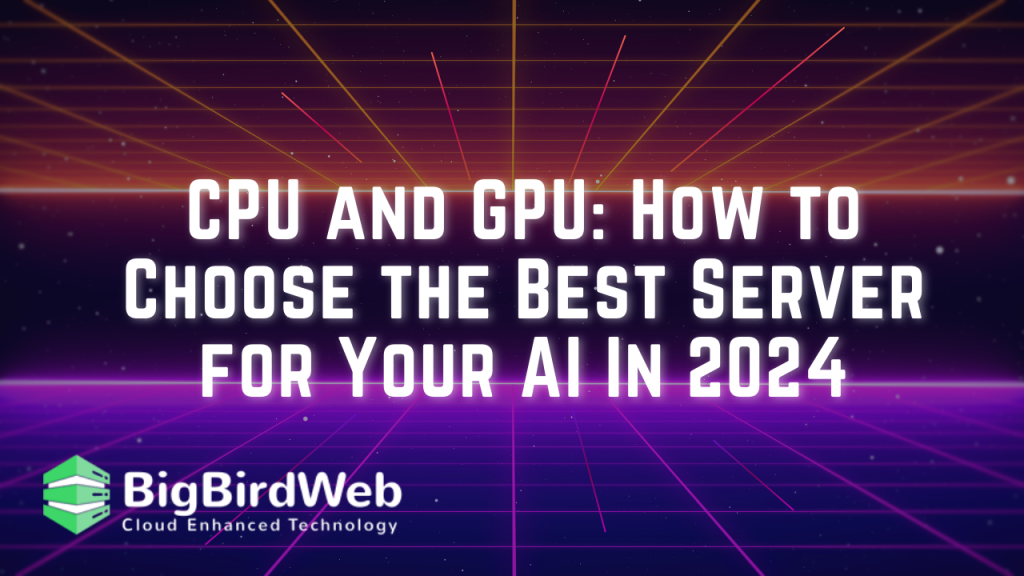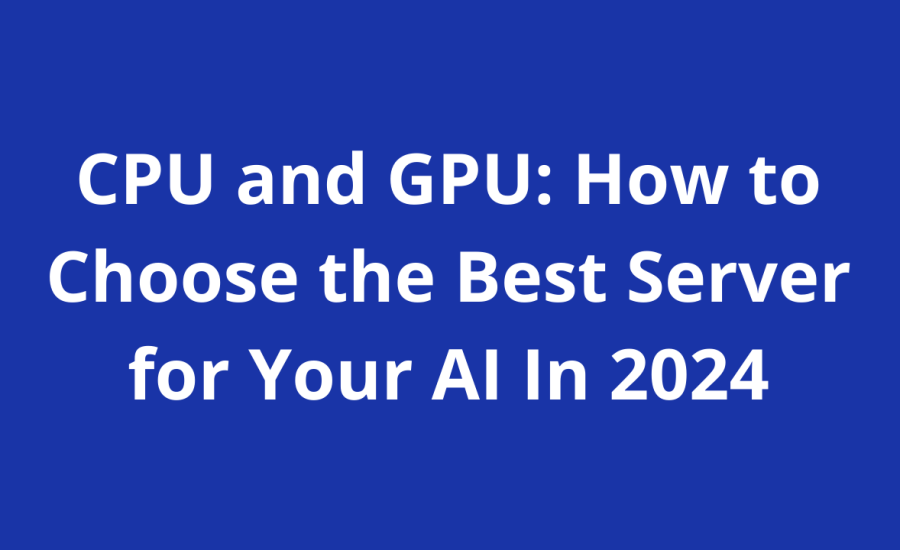When embarking on an artificial intelligence (AI) project, selecting the right hardware is crucial. The heart of this hardware selection revolves around choosing the proper CPU and GPU. These components significantly impact the performance and efficiency of your AI models. In this blog, we will explore how to choose the best server for your AI needs by focusing on the CPU and GPU, ensuring you make an informed decision for optimal results.

Table of Contents
Understanding the Roles of CPU and GPU in AI
CPU (Central Processing Unit)
The CPU is the primary component responsible for executing general-purpose instructions in a server. It handles tasks such as data preprocessing, running algorithms, and managing system resources. While not as specialized as GPUs, a powerful CPU is essential for handling a wide range of tasks and ensuring smooth operation.
GPU (Graphics Processing Unit)
The GPU is designed to handle parallel processing, making it ideal for the heavy computational demands of AI. GPUs excel in tasks involving large datasets and complex mathematical calculations, such as training deep learning models. Their architecture allows for simultaneous processing of multiple operations, significantly speeding up AI tasks compared to CPUs.
Key Factors to Consider When Choosing CPU and GPU for AI
1. Workload Requirements
Understanding your AI workload is the first step in selecting the proper CPU and GPU. Determine the complexity and type of tasks your AI models will perform. For example, deep learning tasks involving neural networks will benefit more from a powerful GPU, while general data processing might rely more on the CPU.
2. Performance Metrics
Evaluate the performance metrics of both CPU and GPU. For CPUs, look at the number of cores, clock speed, and cache size. More cores and higher clock speeds generally mean better performance web hosting for parallel tasks. For GPUs, consider the number of CUDA cores, memory bandwidth, and VRAM capacity. Higher CUDA cores and memory bandwidth are crucial for handling extensive computations.
3. Compatibility and Integration
Ensure the CPU and GPU you choose are compatible with your server and software stack. Check the compatibility with your chosen AI frameworks (like TensorFlow or PyTorch) and ensure the hardware integrates seamlessly with your existing infrastructure. Compatibility issues can lead to bottlenecks and reduced performance.
4. Scalability
Future-proof your investment by considering the scalability of your CPU and GPU. As your AI projects grow, you may need to upgrade or add more hardware. Opt for servers that allow easy upgrades and have ample space for additional GPUs if needed. Scalability ensures your infrastructure can handle increasing demands over time.
5. Power Consumption and Cooling
AI workloads can be power-intensive, making it essential to consider power consumption and cooling solutions. Both CPU and GPU generate significant heat, and efficient cooling mechanisms are crucial to maintain optimal performance. Look for servers with advanced cooling systems and energy-efficient hardware to manage power consumption effectively. You can also opt for free web hosting.
6. Budget Constraints
Balance your performance needs with your budget constraints. High-end CPU and GPU models offer superior performance but come at a higher cost. Evaluate your budget and prioritize components that provide the best value for your specific AI tasks. It’s often beneficial to start with a mid-range setup and scale up as your projects demand.
Recommended CPUs for AI
1. AMD Ryzen Threadripper
AMD Ryzen Threadripper CPUs are known for their high core counts and exceptional multi-threading capabilities. They offer excellent performance for parallel processing tasks, making them ideal for AI workloads that require significant CPU power.
2. Intel Xeon Scalable Processors
Intel Xeon Scalable Processors are designed for data centers and enterprise applications. They provide robust performance, reliability, and scalability, making them suitable for AI tasks that demand high processing power and stability.
3. AMD EPYC Processors
AMD EPYC processors offer high core counts, substantial memory bandwidth, and energy efficiency. They are well-suited for AI workloads that require extensive parallel processing and efficient power consumption.
Recommended GPUs for AI
1. NVIDIA A100 Tensor Core GPU
NVIDIA A100 Tensor Core GPUs are specifically designed for AI and deep learning tasks. They offer exceptional performance with a large number of CUDA cores, high memory bandwidth, and support for multi-instance GPU technology, allowing multiple AI models to run simultaneously.
2. NVIDIA GeForce RTX 3090
The NVIDIA GeForce RTX 3090 is a powerful consumer-grade GPU that provides excellent performance for AI workloads. It features ample VRAM, high CUDA core counts, and efficient cooling, making it a cost-effective option for AI enthusiasts and small to medium-sized projects.
3. AMD Radeon Instinct MI100
The AMD Radeon Instinct MI100 is a high-performance GPU designed for AI and machine learning tasks. It offers competitive performance with extensive memory bandwidth and support for advanced AI frameworks, making it a viable alternative to NVIDIA GPUs.
FAQs
1. Why are GPUs important for AI?
GPUs are crucial for AI because they excel in parallel processing, which is essential for handling large datasets and complex computations. They significantly speed up tasks such as training deep learning models, making them indispensable for AI projects.
2. Can I use a server with only a powerful CPU for AI?
While a powerful CPU can handle many AI tasks, a GPU is recommended for tasks involving extensive parallel processing, such as deep learning. Combining both ensures optimal performance and efficiency for a wide range of AI applications.
3. How do I ensure compatibility between my CPU, GPU, and AI frameworks?
To ensure compatibility, check the documentation of your chosen CPU and GPU and the AI frameworks you plan to use. Most AI frameworks provide guidelines on compatible hardware. Additionally, consider consulting with your hardware and software vendors for specific compatibility advice.
4. What is the role of VRAM in GPUs for AI?
VRAM (Video RAM) in GPUs is essential for storing and quickly accessing large datasets during AI computations. Higher VRAM capacity allows for processing more extensive datasets and complex models, resulting in improved performance and efficiency.
Bonus Content: Optimizing Your AI Server Setup
1. Utilize Cloud Services
Consider using cloud-based AI services for additional flexibility and scalability. Cloud providers offer powerful CPU and GPU instances that can be scaled up or down based on your needs. This can be cost-effective for handling variable workloads and large-scale projects.
2. Leverage AI Frameworks and Libraries
Utilize optimized AI frameworks and libraries that are designed to take full advantage of your CPU and GPU. Frameworks like TensorFlow, PyTorch, and CUDA provide tools and optimizations that can significantly enhance the performance of your AI models.
3. Monitor and Optimize Performance
Regularly monitor the performance of your CPU and GPU to identify any bottlenecks or inefficiencies. Use performance monitoring tools and benchmarks to optimize resource allocation and ensure your AI server is operating at peak efficiency.
4. Keep Software Up to Date
Ensure your AI frameworks, drivers, and firmware are up to date to leverage the latest performance enhancements and features. Regular updates can provide significant improvements in compatibility, stability, and performance for your CPU and GPU.
By carefully considering the proper CPU and GPU for your AI needs and optimizing your server setup, you can ensure your AI projects run efficiently and effectively. Stay informed about the latest hardware advancements and best practices to maintain a cutting-edge AI infrastructure.
